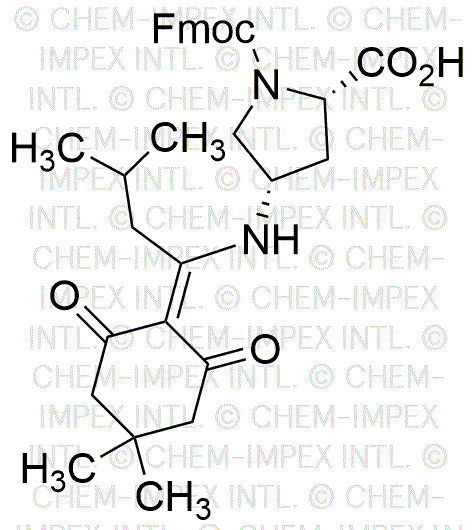N-Fmoc-(4S-NH-(4,4-Dimethyl-2,6-dioxocyclohex-1-ylidene)-3-methylbutyl-L-proline is widely utilized in research focused on:
- Peptide Synthesis: This compound serves as a protective group in solid-phase peptide synthesis, allowing for the selective modification of amino acids without affecting the overall structure. This is crucial for creating complex peptides with specific functions.
- Drug Development: It plays a significant role in the pharmaceutical industry, particularly in designing peptide-based drugs. Its unique structure can enhance the bioavailability and stability of therapeutic peptides, making it valuable in drug formulation.
- Bioconjugation: The compound is used in bioconjugation techniques to link peptides to other biomolecules, such as antibodies or enzymes. This application is essential in developing targeted therapies and diagnostic tools in biotechnology.
- Research in Neuroscience: It is utilized in studies related to neuropeptides, which are crucial for understanding various neurological functions and disorders. The ability to modify neuropeptides can lead to new insights into brain chemistry.
- Material Science: The compound can be incorporated into polymer systems to create smart materials with responsive properties. This application is beneficial in developing advanced materials for sensors and drug delivery systems.
Informations générales
Propriétés
Sécurité et réglementation
Applications
N-Fmoc-(4S-NH-(4,4-Dimethyl-2,6-dioxocyclohex-1-ylidene)-3-methylbutyl-L-proline is widely utilized in research focused on:
- Peptide Synthesis: This compound serves as a protective group in solid-phase peptide synthesis, allowing for the selective modification of amino acids without affecting the overall structure. This is crucial for creating complex peptides with specific functions.
- Drug Development: It plays a significant role in the pharmaceutical industry, particularly in designing peptide-based drugs. Its unique structure can enhance the bioavailability and stability of therapeutic peptides, making it valuable in drug formulation.
- Bioconjugation: The compound is used in bioconjugation techniques to link peptides to other biomolecules, such as antibodies or enzymes. This application is essential in developing targeted therapies and diagnostic tools in biotechnology.
- Research in Neuroscience: It is utilized in studies related to neuropeptides, which are crucial for understanding various neurological functions and disorders. The ability to modify neuropeptides can lead to new insights into brain chemistry.
- Material Science: The compound can be incorporated into polymer systems to create smart materials with responsive properties. This application is beneficial in developing advanced materials for sensors and drug delivery systems.
Documents
Fiches de données de sécurité (FDS)
La FDS fournit des informations de sécurité complètes sur la manipulation, le stockage et l’élimination du produit.
Spécifications du produit (PS)
Le PS fournit une description complète des propriétés du produit, notamment sa composition chimique, son état physique, sa pureté et les exigences de stockage. Il détaille également les plages de qualité acceptables et les applications prévues du produit.
Certificats d'analyse (COA)
Recherchez des certificats d'analyse (COA) en saisissant le numéro de lot du produit. Les numéros de lot et de lot se trouvent sur l'étiquette d'un produit, après les mots « Lot » ou « Lot de fabrication ».
Numéro de catalogue
Numéro de lot/série
Certificats d'origine (COO)
Ce certificat d'exploitation confirme le pays dans lequel le produit a été fabriqué, et détaille également les matériaux et composants utilisés et s'il est issu de sources naturelles, synthétiques ou autres sources spécifiques. Ce certificat peut être requis pour les douanes, le commerce et la conformité réglementaire.
Numéro de catalogue
Numéro de lot/série
Fiches de données de sécurité (FDS)
La FDS fournit des informations de sécurité complètes sur la manipulation, le stockage et l’élimination du produit.
DownloadSpécifications du produit (PS)
Le PS fournit une description complète des propriétés du produit, notamment sa composition chimique, son état physique, sa pureté et les exigences de stockage. Il détaille également les plages de qualité acceptables et les applications prévues du produit.
DownloadCertificats d'analyse (COA)
Recherchez des certificats d'analyse (COA) en saisissant le numéro de lot du produit. Les numéros de lot et de lot se trouvent sur l'étiquette d'un produit, après les mots « Lot » ou « Lot de fabrication ».
Numéro de catalogue
Numéro de lot/série
Certificats d'origine (COO)
Ce certificat d'exploitation confirme le pays dans lequel le produit a été fabriqué, et détaille également les matériaux et composants utilisés et s'il est issu de sources naturelles, synthétiques ou autres sources spécifiques. Ce certificat peut être requis pour les douanes, le commerce et la conformité réglementaire.


